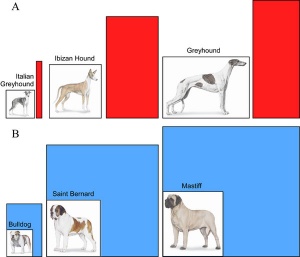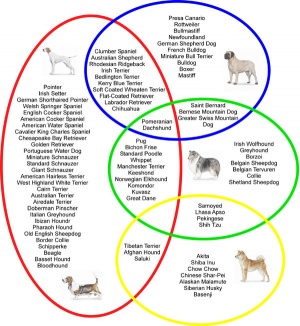Dog Development: Difference between revisions
| Line 1: | Line 1: | ||
==Introduction== | ==Introduction== | ||
[[File:Dog breeds 01.jpg|thumb|Dog breeds]] | [[File:Dog breeds 01.jpg|thumb|Dog breeds]] | ||
The domestic dog (Canis lupus familiaris) has been derived from an ancestoral wolf and now consists of a breed family of more than 300 worldwide, with extensive variations in morphology (size, shape and weight). The average canine gestation period from ovulation to birth (parturition) approximately 64 days. | The domestic dog (Canis lupus familiaris) has been derived from an ancestoral wolf and now consists of a breed family of more than 300 worldwide, with extensive variations in morphology (size, shape and weight). The average canine gestation period from ovulation to birth (parturition) approximately 64 days. There have been identified about 400 congenital disorders relating to dog development. | ||
--[[User:S8600021|Mark Hill]] 08:28, 21 April 2010 (EST) Content under development (notice removed when complete) | --[[User:S8600021|Mark Hill]] 08:28, 21 April 2010 (EST) Content under development (notice removed when complete) | ||
Revision as of 08:52, 21 April 2010
Introduction
The domestic dog (Canis lupus familiaris) has been derived from an ancestoral wolf and now consists of a breed family of more than 300 worldwide, with extensive variations in morphology (size, shape and weight). The average canine gestation period from ovulation to birth (parturition) approximately 64 days. There have been identified about 400 congenital disorders relating to dog development.
--Mark Hill 08:28, 21 April 2010 (EST) Content under development (notice removed when complete)
| Animal Development: axolotl | bat | cat | chicken | cow | dog | dolphin | echidna | fly | frog | goat | grasshopper | guinea pig | hamster | horse | kangaroo | koala | lizard | medaka | mouse | opossum | pig | platypus | rabbit | rat | salamander | sea squirt | sea urchin | sheep | worm | zebrafish | life cycles | development timetable | development models | K12 |
Taxon
NCBI Taxonomy Browser Canis lupus familiaris (Genbank common name: dog)
Synonyms: Canis familiaris, Canis domesticus, Canis canis
Chromosomes: 40 (38, X, Y)
Genetic code: Translation table 1 (Standard)
Mitochondrial genetic code: Translation table 2 (Vertebrate Mitochondrial)
Lineage( full ):cellular organisms; Eukaryota; Fungi/Metazoa group; Metazoa; Eumetazoa; Bilateria; Coelomata; Deuterostomia; Chordata; Craniata; Vertebrata; Gnathostomata; Teleostomi; Euteleostomi; Sarcopterygii; Tetrapoda; Amniota; Mammalia; Theria; Eutheria; Laurasiatheria; Carnivora; Caniformia; Canidae; Canis; Canis lupus
Development Overview
Days shown below relate to days after ovulation (day 0).
2 to 5 days - fertilization
14 to 16 days - embryo attaches to uterus
22 to 23 days - heartbeat visible
62 to 64 days - parturition (birth or whelping)
Sexual differentiation begins early in the embryonic period prenatally and continues into early postnatal life.
Caudal vena cava development- five theories to origin (right-sided supracardinal, caudal cardinal, sacrocardinal, lateral sympathetic or subcardinal veins).
Placenta
Classified as endotheliochorial placentation forming a zonary placenta, which is a complete girdle in dogs. Three zones: girdle zone (endotheliochorial labyrinth), hemochorial hemophagous zone (marginal hematoma) and polar zone (epitheliochorial free)
Trophoblast cell invasion continues after chorioallantois villous penetration and the materno–fetal interface is described as lamellar, with fetal projections interdigitating with maternal septa.
(Data from: Miglino MA, etal., 2006 and other sources)
Estrous Cycle
Estrus, also called "in heat" is the time of sexually receptivity and occurs every 17 to 21 days.
Ovulation occurs 5 to 6 days prior to the first day of diestrus and is indicated by plasma progesterone concentrations higher than 2 ng/mL. Parturition (birth or whelping) occurs between 62 to 64 days after ovulation.
Links: Estrous Cycle)
Abnormalities
- Cardiac Defects
- Hip dysplasia
- Congenital renal disease
Other
- Canine Eclampsia - (puerperal tetany, hypocalcemia) develops mainly in small-breed dogs with large litters.
- Brucellosis - male and female can be carriers of this sexually transmitted disease.
References
Reviews
Articles
Search Pubmed
Search Pubmed Now: dog development | canine development | Estrous Cycle |
| Animal Development: axolotl | bat | cat | chicken | cow | dog | dolphin | echidna | fly | frog | goat | grasshopper | guinea pig | hamster | horse | kangaroo | koala | lizard | medaka | mouse | opossum | pig | platypus | rabbit | rat | salamander | sea squirt | sea urchin | sheep | worm | zebrafish | life cycles | development timetable | development models | K12 |
Glossary Links
- Glossary: A | B | C | D | E | F | G | H | I | J | K | L | M | N | O | P | Q | R | S | T | U | V | W | X | Y | Z | Numbers | Symbols | Term Link
Cite this page: Hill, M.A. (2024, May 22) Embryology Dog Development. Retrieved from https://embryology.med.unsw.edu.au/embryology/index.php/Dog_Development
- © Dr Mark Hill 2024, UNSW Embryology ISBN: 978 0 7334 2609 4 - UNSW CRICOS Provider Code No. 00098G

